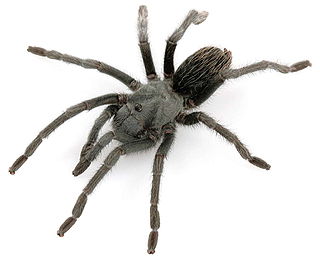
Aphonopelma chalcodes, commonly known as the western desert tarantula, desert blonde tarantula, Arizona blonde tarantula or Mexican blonde tarantula, is a species of spider belonging to the family Theraphosidae. It has a limited distribution in the deserts of Arizona and adjacent parts of Mexico but can be very common within this range. The common name "blonde tarantula" refers to the carapace, which is densely covered in pale hairs, and contrasts strongly with the all-dark legs and abdomen. Additionally, these spiders have low toxicity, a long life expectancy, and several offspring.

The Texas brown tarantula, Aphonopelma hentzi, also known as the Oklahoma brown tarantula or Missouri tarantula, is one of the most common species of tarantula living in the Southern United States today. Texas brown tarantulas can grow to leg spans in excess of 10 cm (4 in), and weigh more than 85 g (3 oz) as adults. Their bodies are dark brown, though shades may vary between individual tarantulas. The colors are more distinct after a molt, as with many arthropods.

Aphonopelma anax, commonly known as the Texas tan tarantula, is a species of spider belonging to the family Theraphosidae native to southern Texas and northern Mexico.
Aphonopelma hollyi, also known as the Lubbock gold tarantula, is considered by some sources to be a species of tarantula native to Texas in the United States. Described in 1995, the scientific name honors the 1950s rock-and-roll singer Buddy Holly. Other sources suggest spiders given this name are actually Aphonopelma hentzi.
Aphonopelma chamberlini, also known as the Paso Robles rusty red tarantula, is regarded by some sources as a tarantula species endemic to California, and by others as synonymous with Aphonopelma iodius.

Aphonopelma johnnycashi is a species of tarantula. It was found in 2015 near Folsom Prison in California and named after Johnny Cash, whose song "Folsom Prison Blues" made the prison famous. Mature males are generally black, and the country music singer was also known as "The Man in Black".

Aphonopelma armada is a species of spider in the family Theraphosidae, found in Texas in the United States.

Aphonopelma atomicum is a species of spiders in the family Theraphosidae, found in United States. Like many New World tarantulas, they flick urticating hairs at attackers if threatened.

Aphonopelma steindachneri is a species of spider in the family Theraphosidae, found in United States (California) and Mexico.

Aphonopelma gabeli is a species of spider in the family Theraphosidae, found in United States.

Aphonopelma icenoglei is a species of spiders in the family Theraphosidae, found in United States (California).

Aphonopelma iodius is a species of spider in the tarantula family Theraphosidae, found in United States. A 1997 paper combined it with three other previously described species into a single species, calling it "A. iodium". However, iodius is a neuter comparative adjective and is the correct form. Aphonopelma smithii has also been synonymized with A. iodius. A. iodius is common in the Mojave Desert to the west of the Colorado River.

Aphonopelma joshua is a species of spider in the family Theraphosidae, found in United States (California).

Aphonopelma marxi is a species of spider in the family Theraphosidae (tarantulas), found in United States. Aphonopelma behlei and A. vogelae, at one time considered separate species, are now considered to be synonyms.

Aphonopelma moderatum is a species of spider in the family Theraphosidae, found in United States, in the state of Texas. Commonly called the Rio Grande Gold Tarantula as they are found in the Rio Grande Valley of Texas.

Aphonopelma mojave is a species of spider, in the family Theraphosidae (tarantulas).

Aphonopelma mareki is a species of spider in the family Theraphosidae, found in United States.

Aphonopelma prenticei is a species of spiders in the family Theraphosidae, found in United States.

Aphonopelma xwalxwal is a species of spiders in the family Theraphosidae, found in United States (California).
Aphonopelma phasmus is a species of spider in the family Theraphosidae. It is only known from a single adult male collected near the Colorado River in the Grand Canyon National Park in Coconino County, Arizona. The female is unknown.



















